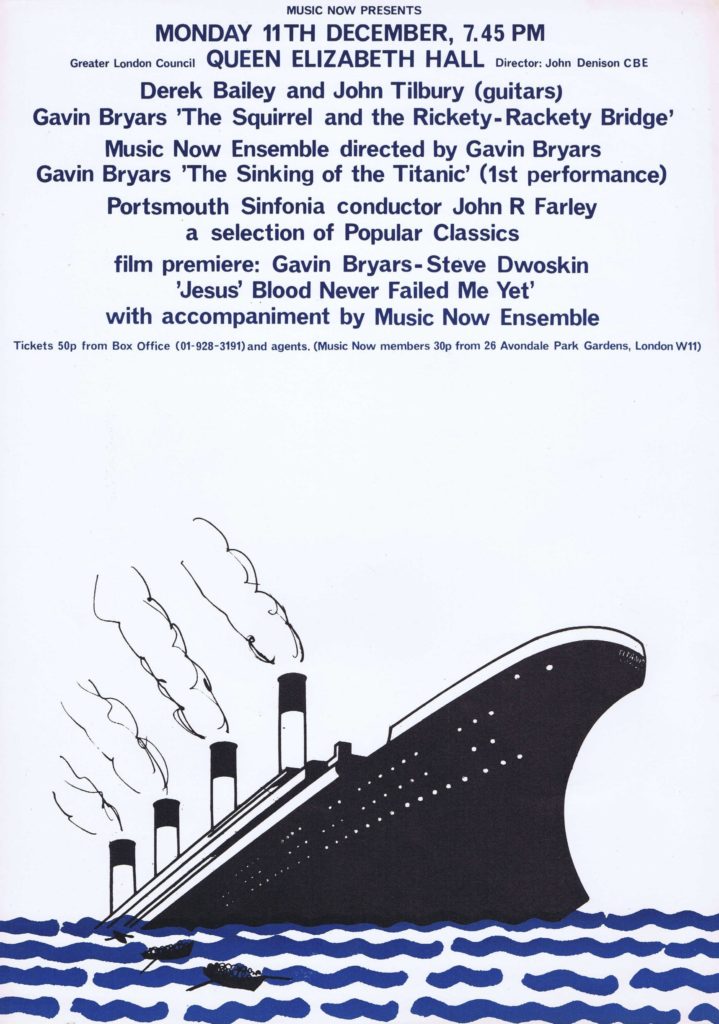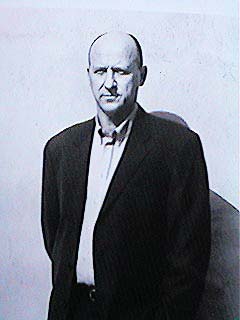The Sinking of the Titanic, Fifty Years On
Feature
Gavin Bryars reveals the impetus behind composing the work and some of the most eventful performances as we approach the 50th anniversary of the piece.
“… the band was still playing… they were playing ‘Autumn’ then. I swam with all my might. I suppose I was 150 feet away when the Titanic on her nose began to settle – slowly… the way the band kept playing was a noble thing… and the last I saw of the band, when I was floating out in the sea with my lifebelt on, it was still on deck playing Autumn. How they ever did it I cannot imagine.” The surviving wireless operator Harold Bride, speaking to the New York Times in April 1912.
All the materials used in the piece are derived from research and speculations about the sinking of the “unsinkable” luxury liner. On April 14th, 1912, the Titanic struck an iceberg at 11.40 PM in the North Atlantic and sank at 2.20 AM on April 15th. The initial starting point for the piece was the reported fact of the band, a small group of string players, having played a hymn in the final minutes of the ship’s sinking in an extraordinary act of self-sacrifice, as an attempt to keep people’s spirits lifted.
The Episcopal hymn Autumn becomes the principle element of the music and is subject to a variety of treatments and forms a base over which other material is superimposed.
The Sinking of the Titanic originated in a sketch written for an art exhibition in 1969. Working as I was in an art college environment, I was interested to see what the musical equivalent of a work of conceptual art. might be, something that could be experienced without physical manifestation, or rather where its physical realisation is not the essence of the work.
It was not until 1972, at the instigation of Victor Schonfield and Music Now that I made a performing version of the piece for part of an evening of my work at the Queen Elizabeth Hall, London (an evening which also included the premiere of Jesus’ Blood Never Failed Me Yet). Over the next three years I performed it a number of times: at “Europalia” in Brussels, 1973; with John Adams at the San Francisco Conservatory of Music, 1974. And then recorded the essence of these various versions in 1975 for Brian Eno’s Obscure Records label. This recording, with Jesus’ Blood as the ‘B’ side, was the first of the ten records that comprised Obscure’s almost legendary output.

In 1990 a live recording was made at the Printemps de Bourges festival when the discovery of the wreck had caused me to think again about the music. This version also formed the basis for the 1994 recording on Point. There have been subsequent recordings by Alter Ego, On Touch, and by the Gavin Bryars Ensemble, on GB Records, for the 2012 Titanic centenary year. The original Obscure Recording was remastered and released on GB Records in 2018.
Some of this material might seem puzzling but it is all rooted in fact. The prologue by Philip Jeck can be seen as a reference to Phillips, the lonely wireless operator who remained on the ship; the sustained “crash” sounds early in the performance are derived from descriptions by survivors of the impact of the iceberg on the ship. Other references include the sound of a football crowd (“like 100,000 people at the cup final”) and the sound of crickets in a field in Pennsylvania which are two of the similes used to describe the sound of people in the water (and the recordings I use are precisely those: of a cup final crowd, and of crickets recorded in the fields of Pennsylvania). A music box to play the tune La Maxixe just as did the one inside a toy pig that Miss Russell used to amuse and distract children in the lifeboat…
The recorded speaking voices are those of survivors, Edith Russell and Eva Hart, who I interviewed in 1972 just before the first live performance of the piece.
There have been many extraordinary performances in the last fifty years. Perhaps the most dramatic was in a water tower in Bourges built in Napoleonic times where we were recording live for Les Disques du Crepuscule in 1990. We played in the lowest level of the circular tower, the audience was on the next floor, watching and listening through CCTV. My sound engineer Chris Ekers used the huge open-top floor as a reverberation chamber and so some of the sound was heard in the town. We were told that when the water tower was working, water ran down the outside of the wall and flowed down the hill. As the music was being heard publicly, we thought it would be nice to find out how to do this too. We eventually found the tap that was used for this little flow of water and had it turned on during the performance as a sign that the tower had come back to life.
What we didn’t know was that some of the water was circulated back into the bottom space (where we were playing). As we were performing – raised on wooden risers, with lots of electronics on them – we saw the water start to lap around the small platforms, rising inch by inch as we played but because we were recording live we kept playing for the full hour so that the recording could be completed. As soon as we had finished, we jumped off the platforms and rushed upstairs, turned off the tap, and unplugged the electricity. We performed a second time, but without the tap.

Although I have played this piece in many countries, with many musicians, in many different ways, and sometimes in curious locations, it is still something that touches me fifty years on. To perform it this year at Kings Place with my own ensemble, some of whom have played it for almost as long as I have, will be a very special experience.